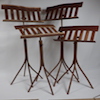I have to make 3 floating shelves that are 10ft long x 10" deep, approx 1.5" thick. I know there are plenty of manufactured steel brackets like Sheppard Brackets, but id love to save some money and use some 1/2-3/4" all thread if possible. The all thread would be inserted directly into the stud, and then into corresponding holes on the back of the shelves.
Has anyone taken this approach before? Is it stronger if I just use sheppard brackets?
Thanks in advance!




 Reply With Quote
Reply With Quote






